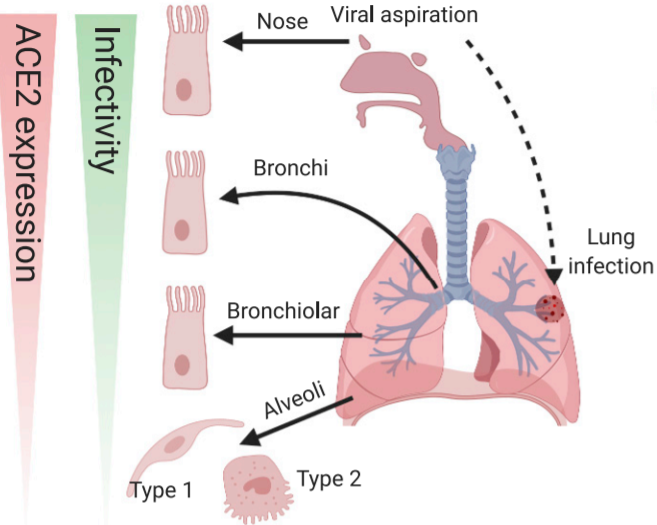
ACE2 expression and infectivity gradient along the respiratory tract. Image source: Hou Y et al. (2020) Cell. DOI: https://doi.org/10.1016/j.cell.2020.05.042
Angiotensin converting enzyme 2 (ACE2) is the receptor used by SARS-CoV-2 to gain entry into cells.
ACE2 Expression is Associated with Infectivity
A new study published in Cell utilized in situ RNA hybridization to map ACE2 expression along the length of the respiratory tract. Staining of healthy lung epithelial tissue samples with RNA probes showed that ACE2 expression is the highest in the upper respiratory tract (nose and oropharynx) and progressively decreases as the airway reaches the alveoli. To investigate how this expression gradient relates to infectivity by SARS-CoV-2, the researchers developed genetically engineered SARS-CoV-2 reporter viruses that fluoresce after successfully infecting a cell. The researchers found that these reporter viruses replicated to higher levels in upper airway cell cultures compared with lower airway cell cultures, which reflects ACE2 expression patterns. Post-mortem lung tissues from COVID-19 patients also showed signs of this infection gradient [1].
Given these results, the researchers suggested a mechanism for how SARS-CoV-2 travels to the lower respiratory tract. Since lower airway cells express low levels of ACE2 and are difficult to infect directly in culture, accumulation of SARS-CoV-2 in the upper airway may be needed before the virus can achieve infection of the lower tract. When the virus enters through the nose, it is first exposed to cells that have high expression of ACE2. Due to the abundance of receptors, the virus could easily replicate and establish infection in this upper region of the airway before moving down to the lower tract with a much higher concentration of virus. If SARS-CoV-2 infection is seeded in the nose, the researchers speculate that therapies aimed at reducing nasal viral titers could help prevent development of severe disease.

ACE2 expression and infectivity gradient along the respiratory tract. Image source: Hou Y et al. (2020) Cell. DOI: https://doi.org/10.1016/j.cell.2020.05.042
|
When recombinant SARS-CoV-2 RBD-Fc Chimera is immobilized at 2 µg/mL, recombinant human ACE2 binds in a dose-dependent manner with EC50 range of 15 - 60 ng/mL.. |
Recombinant Human ACE2 (carrier-free)
Cat No. 792002, 792004, 792006, 792008 Source : Human ACE2, amino acid (Gln18 - Thr740) (Accession: NM_021804.1) was expressed in CHO cells. The carboxyl-terminus contains TG-8His-GGQ - tag. Activity : |
|
Recombinant mouse ACE2 activity is measured by its ability to hydrolyze the fluorogenic peptide substrate, Mca-YVADAPK(Dnp)-OH. The increase of the product was monitored by an increase in intensity of fluorescence at 405 nm with excitation at 320 nm. The specific activity is > 400 pmol/min/µg in the presence of 0.025 µg of recombinant mouse ACE2.. |
Recombinant Mouse ACE2 (carrier-free)
Cat No. 720102, 720104, 720106, 720108 Source : Mouse ACE2, amino acid (Gln18 - Thr740) (Accession: NM_027286.4) was expressed in CHO cells. The carboxyl-terminus contains TG-8His-GGQ - tag. Activity : Mouse angiotensin I-converting enzyme 2 (ACE2) cleaves the fluorogenic peptide substrate, Mca-YVADAPK(Dnp)-OH. The specific activity is > 400 pmol/min/µg in the presence of 0.025 µg of recombinant mouse ACE2. |